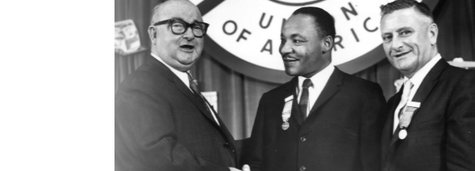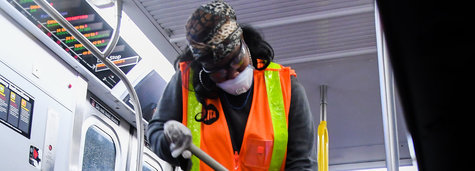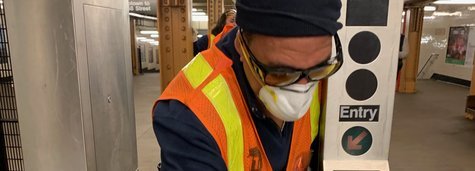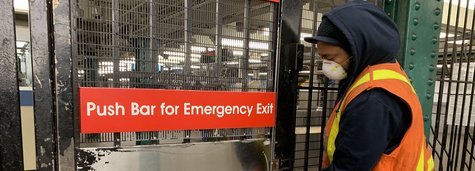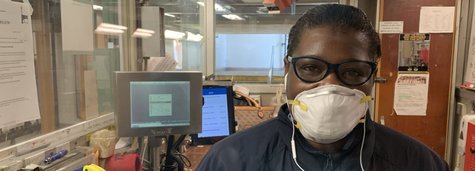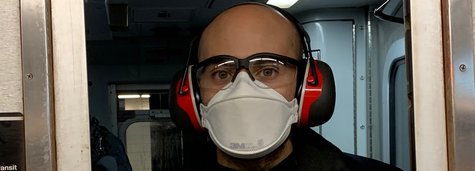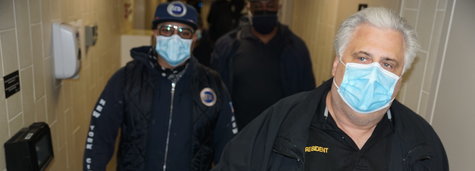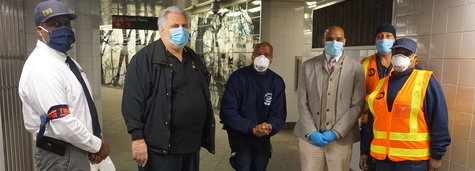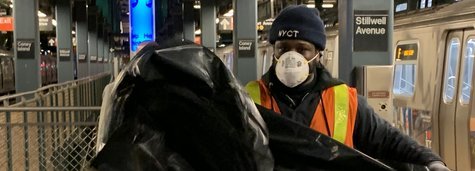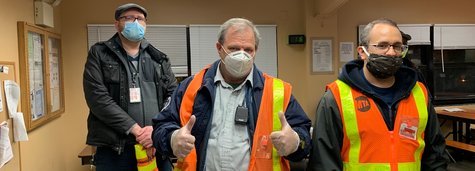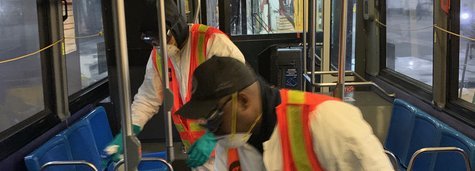Media Links
May 19, 2011
-
Source: FOX News
The NYPD is on the hunt for the teen who opened fire on another teen after a staring match aboard an MTA bus. The shooting occurred on the B60 bus that was approaching a stop at Stanhope Street and Central Avenue in Brooklyn Wednesday afternoon. The suspect is described by police as a Black male, 18-years-old wearing a light blue Holister sweatshirt. EMS rushed the victim to Elmhurst Hospital in stable condition, according to police.
-
Source:
-
Source: NY PostThe 7 train's hellish ride will get worse before it gets better. The line -- recently battered by horrendous delays -- will be shut down between Queensboro Plaza and Times Square this weekend and two others (June 24-27 and July 29-Aug. 1) for repairs. The line's half-million riders...
-
Source: Streetsblog
A new paper underscores how the design of a subway map can impact passengers' travel decisions.
New York City’s subway map has a tortured existence. As I’ve written many times over the past four and a half years, the map is not quite schematic and not quite geographically accurate, and thus, it serves only as a loose proxy for navigation throughout the city. According to a new study, that could lead to warped perceptions about New York.
In a paper entitled “Mind the map! The impact of transit maps on path choice in public transit,” NYU graduate professor Zhan Guo explores how cartographical distortions can impact people’s relationships with the city writ large. The Transportationist highlights the paper’s conclusion (and a working paper edition is available online). It reads, in part:
The case study on the London Underground confirms that a schematic transit map indeed affects passengers’ path choices. Moreover, the map effect is almost two times more influential than the actual travel time. In other words, underground passengers trust the tube map (two times) more than their own travel experience with the system. The map effect decreases when passengers become more familiar with the system but is still greater than the effect of the actual experience, even for passengers who use the underground 5 days or more per week.
The paper also shows that the codification of transfer connections is also important. Different codification can make a transfer look more or less convenient on a transit map than in reality, which will either decrease or increase the perceived transfer inconvenience for the corresponding stations. This paper observes both situations in the underground case study and quantifies this codification effect, in terms of the number of attracted or precluded transfers, for four major transfer stations: Baker St., Bank/Monument, Victoria, and Oxford Circus.
Of course, these results are only based on the London Underground, a unique case in many aspects. Few transit maps enjoy such public popularity as the tube map in London. Many transit maps include prominent geographical features, which dilute the map effect. Other systems have different past or present versions of their transit map, which precludes a lasting and stable map effect. Many metropolitan regions possess an easier-to-comprehend urban form than London, which could weaken the role of a transit map in the formation of a cognitive map. The subway map effect in New York City is probably different from that in London. Therefore, readers should be cautious about making generalizations.
In spite of the last sentence in the excerpt above. Guo ponders how maps can impact transit operations and planning. A map, he says, “might unintentionally shift more passengers to a congested segment in the network and thus form a bottleneck” and a modification of a map could “change passenger behavior and mitigate platform and train crowding.” It’s the ultimate in human behavioral manipulation underground.
Over at Greater Greater Washington, David Alpert explored how applying Guo’s findings could impact the DC map. The changes, he notes, are not necessarily positive ones. A redesigned DC map would better show various landmarks in relationship with each other — Union Station’s proximity to the Capitol is one example — but it doesn’t necessarily improve overall system use.
“This is less useful in many ways than the classic map,” Alpert writes. “Most riders travel to and from stations in the core, and tourists or other riders unfamiliar with the system are most likely of all to do so. This map gives little space to that area and leaves large amounts of empty space at the edges.”
In New York, our map suffers from this problem in certain hub areas. It’s tough to tell how far places in Midtown are from the subway, and transfers are often distorted. For instance, the current iteration of the subway map makes no mention of the fact that the Q and N stop at a different platform at Canal St. than the R train does, and the transfer from the Shuttle to the C at Franklin Ave. in Brooklyn in deceptively far.
Ultimately, as Guo writes, “individual passengers and transit agencies should ‘mind the map’ in order to make their best planning decisions.” It is yet another consideration to ponder as the subway map, always a popular topic of conversation and debate, is revised and reevaluated.
©2011 Second Ave. Sagas. All Rights Reserved.
.
May 17, 2011
-
Source:Source: TimesUnion
-
Source:According to a new report by Milliman, a global consulting and actuarial firm, the total cost of healthcare for the average family of four, if covered by a preferred provider organization, is now a record $19,393.
-
Source: DNA Info
-
Source: Tri-State Transportation Campaign
Groups Urge Greater Oversight and Public Process for Bus Privatization
Mobilizing the Region (blog)
Faced with stonewalling by the Mangano Administration on details of the private vendors' plans for one of the nation's largest suburban bus systems, the groups, which included the Tri-State Transportation Campaign, Long Island Federation of Labor, ...
and more » -
Source:SAY WHAAAT? Mayor Bloomberg had folks questioning what planet he was on Monday when he declared "there aren't very many panhandlers left" in city subways. Our Leo Standora reports: Bloomberg got irritated when the question of panhandlers came up in a press conference. He cut off the ...
-
Source: NY Daily News
New York Daily News
Making tracks in memory of fallen transit co-workers
New York Daily News
Subway signal maintainers Eric Lamono, Lenny Matola, Dominick Spagnolo and Ray DeGeronimo stand beside wreath left to mark spot where Daniel Walsh and Robert Nicholson were killed. Dominick Spagnolo, a subway signal maintainer, ...
-
Source:Source: Bloomberg
May 16, 2011
-
Source:ALBANY, N.Y. — Gov. Andrew Cuomo will soon announce a proposal for a new, less generous pension system for future state, local and school employees that is designed to save taxpayers $93 billion over 30 years, according to two officials briefed on the plan. If approved by the Legislature, the...
-
Source:The transit website HopStop.com now lets commuters can check how many calories they are burning on their walks to work.
-
Source:A treacherous Queensboro Bridge offramp that has already claimed two lives was the scene of another spectacular crash early yesterday.
-
Source: New York Post
New York Post
Buses hit new 'low'
New York Post
The MTA's newest buses have New Yorkers scratching their heads at the numskull design, where riders 5-foot-2 or taller can easily hit their noggins on the low roofs. The Nova Diesel Standards are 61.5 inches high at their lowest point ...
-
Source:
-
Source:
- Likely Bloomberg Taxi Plan: 1,500 New Medallions Plus 6,000 Borough-Only Cabs (Post)
- Port Authority Tolls Likely to Rise, But What Will Christie Buy With the Revenue? (NYT)
- Another Driver Traveling at Highway Speed Crashes Off Queensboro Bridge Ramp (Post)
- Jim Walden Won’t Bike in NYC With His Three Young Kids (Crain’s)
- On New Buses, Ceilings Too Low and Seats Too Small, Says Post
- Long Island Teen Kills 9-Year-Old on Bike While Learning to Drive (Post)
- Cab Driver Barrels Into Midtown Starbucks (Gothamist)
- Helen Marshall OKs 600 Parking Space Reduction for Long Island City Office Tower (Queens Chron)
- Mid-Block Crosswalks Could Connect Midtown’s Network of Private Plazas (DNAinfo)
- Ride Along With the Livery Cab Crackdown (Post)
- Greenwich Village Residents Like Idea of Plaza, Terrified of “Revelers” Sitting Down (Villager)
- New Hopstop Feature Counts Calories Burned While Walking to Transit (Post)
More headlines at Streetsblog Capitol Hill
May 13, 2011
-
Source: StreetsblogIf you’re a middle-income person living in the Philadelphia metro area, there’s an 85 percent chance you live within three-quarters of a mile of a transit stop, and you probably have to wait about 12 minutes for a bus or train. But if you’re looking for work, beware: only 20 percent of the jobs in the region are accessible to you via transit in a reasonable amount of time.
-
Source: Gotham Gazette
Labor and city leadership collided this afternoon at a packed and feisty hearing on legislation to require city subsidized developers pay a living wage.
-
Source: Second Ave. SagasThe MTA’s current five-year capital program, unfunded after 2011 and facing a $10-$13 billion funding gap, will live or die this fall, according to a report today by Crain’s Insider. The city’s daily newsletter reports today that Cuomo Administration will wait until the fall to attempt to usher through a political and economic compromise that will save the MTA’s ambitious capital improvement budget.

